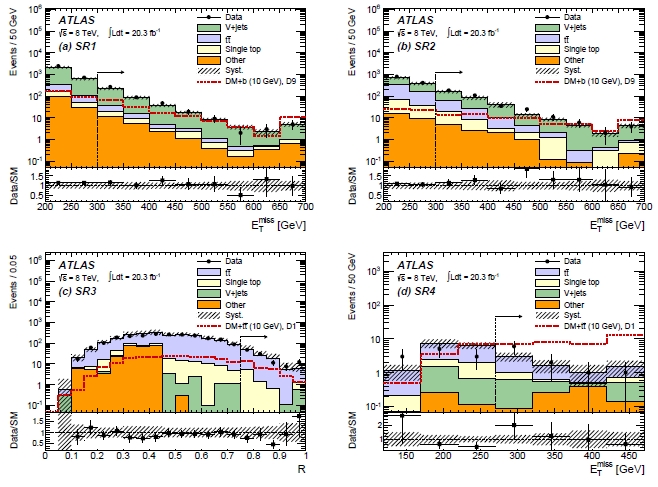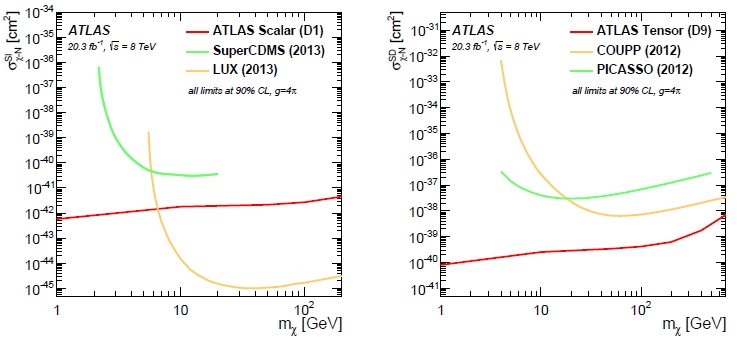At a collider, what may be sought rather than the interaction of one DM particle -let us call it χ for simplicity- with a nucleon is the production of a χ pair together with some other detectable particle in the final state of the collision. The produced χ's escape undetected, and one is left observing the remaining standard model particles, which however collectively exhibit an imbalance in the momentum flow out of the collision point, in the direction transverse to the beams. That is because the two DM bodies "take away" momentum unseen: like grandma on a bike being hit by an invisible truck, they betray the truck's presence by their unnatural recoil pattern.
The novelty of the new ATLAS search is the use of bottom quarks as the recoiling particles. In earlier searches the experiments focused on "cleaner" probes of the production process, such as W or Z bosons, or energetic photons. However, a recent study found that looking for b-quark jets and missing energy could be a viable strategy to search for the χ pair production signature.
ATLAS searches for events containing b-tagged jets and missing transverse momentum. The b-tagging is performed by a multi-variate algorithm, and the operating point is chosen such that the efficiency to correctly identify a bottom-quark-originated jet as such is around 70%; this brings in a 15-20% charm quark misidentification probability, and a 1% chance of tag light-quark or gluon jets; the tradeoff is advantageous as the significant missing momentum is a powerful way to remove backgrounds anyway.
The data are selected in four separate signal regions, which are sensitive to DM production in association with one or two b-jets, or top quark pairs decaying hadronically or in the single-lepton final state. The first two signal regions are dominated by the irreducible background of Z decays to neutrino pairs accompanied by jets: neutrinos behave exactly like dark matter particles as far as the detector is concerned, so one needs to study the kinematics for additional separation power.
In the top plus DM categories, of course the standard model production of top quark pairs dominates backgrounds; the single-lepton signal region is however the cleanest one, as the criteria on the missing momentum are made very tight. In the signal region devoted to all-hadronic top decays the search employs a "razor variable" R, a kinematic feature of the events which I cannot describe here. The data in the four regions are shown in the graph below as black points with error bars, while backgrounds are described by coloured histograms; a dark-matter signal model (a χ with 10 GeV mass) is overlaid in red. The variable shown is missing transverse energy for signal regions 1,2, and 4 (resp. top left and right, and bottom right), and the R variable for signal region 3. The lower panel of each graph shows the ratio between observed data and standard model prediction, indicating that there is no excess anywhere in the spectra.

No signal is observed in any of the four boxes, so ATLAS sets limits on the nucleon-DM cross section. The sensitivity to light dark matter particles makes these limits the best ones in the low-mass region, as is evident from the graphs below. These are shown separately for the spin-independent (left) and spin-dependent (right) cross sections. Note the favourable comparison with the results of the most competitive direct search experiments.

In conclusions, the ATLAS search increases significantly the sensitivity with respect to past searches, but no signal is found. As attractive as DM existence is as an economical explanation of a wealth of cosmological observations, the nature of dark matter continues to remain unknown.




Comments